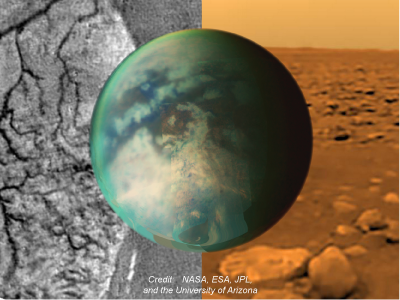 |
Circling the planet Saturn is one of the most enigmatic worlds in our Solar System. Technically a moon, Titan has a diameter of 5,150 km and is slightly larger than the planet Mercury. Unique among moons, Titan has a solid surface, a dense atmosphere, oceans, rivers, and even weather! Out of a hundred or so planets and moons in our Solar System, only four have solid surfaces and substantial atmospheres: Earth, Mars, Venus, and Titan. Like Earth, Titan has rainstorms, seasons, river valleys, mountains, and oceans. Unlike Earth, however, the temperature on Titan is so cold that the liquid in Earth’s rivers and oceans is the same substance that makes solid mountains on Titan. The gases that might be in Earth’s atmosphere fall as liquid rain on Titan and flow in its mysterious dark rivers. 
|
 The mean surface temperature on Titan is −190ºC (−270ºF). At this extremely low temperature the phases of ordinary matter become very different from what we experience on balmy Earth. For example, water is as hard as granite. Titan’s rocks and surface are largely water ice with hydrocarbons mixed in. Liquid water on Titan is more analogous to volcanic magma here on Earth. Instead of H2O, Titan’s “water cycle” consists of liquid methane and ethane. The boiling point of methane (CH4)—the natural gas used for cooking and heating on Earth—is −161ºC, about 30° above Titan’s surface temperature. Flammable natural gas and ethane flow in vast rivers and collect in deep oceans on Titan. Titan’s lakes and oceans contain hundreds of times more hydrocarbon fuels than all the known reserves of fossil fuels on Earth. Unfortunately, these vast resources are also 1.3 billion kilometers away, nearly 10 times the distance from Earth to the Sun.
The mean surface temperature on Titan is −190ºC (−270ºF). At this extremely low temperature the phases of ordinary matter become very different from what we experience on balmy Earth. For example, water is as hard as granite. Titan’s rocks and surface are largely water ice with hydrocarbons mixed in. Liquid water on Titan is more analogous to volcanic magma here on Earth. Instead of H2O, Titan’s “water cycle” consists of liquid methane and ethane. The boiling point of methane (CH4)—the natural gas used for cooking and heating on Earth—is −161ºC, about 30° above Titan’s surface temperature. Flammable natural gas and ethane flow in vast rivers and collect in deep oceans on Titan. Titan’s lakes and oceans contain hundreds of times more hydrocarbon fuels than all the known reserves of fossil fuels on Earth. Unfortunately, these vast resources are also 1.3 billion kilometers away, nearly 10 times the distance from Earth to the Sun. 
|
On January 14, 2005, the Huygens probe, a joint effort between NASA and the European Space Agency (ESA), landed on Titan. Huygens is the first and only human technology to land in the outer Solar System. The car-sized probe took more than eight years to reach Titan and carried enough battery power to collect data for 90 minutes on Titan’s surface. 
|
| |
|

